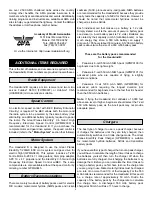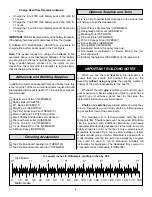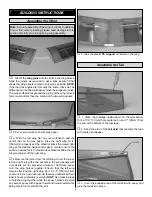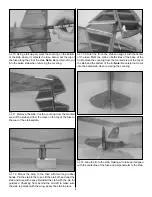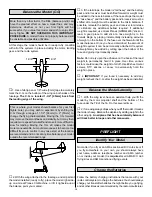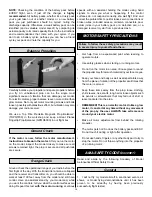
NOTE: Checking the condition of the battery pack before
EVERY flight, even if just off the charger, is highly
recommended. All battery packs, whether it’s a trusty pack
you’ve just taken out of another model, or a new battery
pack you just purchased, should be cycled, noting the
discharge capacity. Oftentimes, a weak battery pack can be
identified (and a valuable model saved!) by comparing its
actual capacity to its rated capacity. Refer to the instructions
and recommendations that come with your cycler. If you
don’t own a battery cycler, perhaps you can have a friend
cycle your pack and note the capacity for you.
Carefully balance your propeller and spare propellers before
you fly. An unbalanced prop can be the single most
significant cause of vibration that can damage your model.
For electric motors, proper balance is even more critical than
glow motors. Not only will motor mounting screws and bolts
loosen, possibly with disastrous effect, but vibration may also
damage your radio receiver.
We use a Top Flite Precision Magnetic Prop Balancer
™
(TOPQ5700) in the workshop and keep a Great Planes
Fingertip Prop Balancer (GPMQ5000) in our flight box.
If the motor is new, follow the motor manufacturer’s
instructions to break-in the motor. After you run the motor
on the model, inspect the model closely to make sure all
screws remained tight, the prop is secure and all pushrods
are secure.
Ground check the operational range of your radio before the
first flight of the day. With the transmitter antenna collapsed
and the receiver and transmitter on, you should be able to
walk at least 100 feet away from the model and still have
control. Have an assistant stand by your model and, while
you work the controls, tell you what the control surfaces are
doing. Repeat this test with the motor running at various
speeds with an assistant holding the model, using hand
signals to show you what is happening. If the control
surfaces do not respond correctly, do not fly! Find and
correct the problem first. Look for loose servo connections or
broken wires, corroded wires on old servo connectors, poor
solder joints in your battery pack or a defective cell, or a
damaged receiver crystal from a previous crash.
•
Get help from an experienced pilot when learning to
operate motors.
•
Use safety glasses when starting or running motors.
•
Do not run the motor in an area of loose gravel or sand;
the propeller may throw such material in your face or eyes.
•
Keep your face and body as well as all spectators away
from the plane of rotation of the propeller at all times that
the motor is armed.
•
Keep these items away from the prop: loose clothing,
shirt sleeves, ties, scarfs, long hair or loose objects such
as pencils or screwdrivers that may fall out of shirt or
jacket pockets into the prop.
•
REMEMBER! This is an electric motor. Unlike a glow
motor, it can start at any time without any movement
of the prop by the user. ALWAYS take extreme care
around your electric motor.
•
Make all motor adjustments from behind the rotating
propeller.
•
The motor gets hot! So does the battery pack and ESC.
Do not touch it during or right after operation.
•
Do not use hands, fingers or any other body part to try to
stop the motor. Do not throw anything into the propeller
of a running motor.
Read and abide by the following Academy of Model
Aeronautics Official Safety Code:
1.
I will not fly my model aircraft in sanctioned events, air
shows, or model flying demonstrations until it has been
proven to be airworthy by having been previously
successfully flight tested.
General
AMA SAFETY CODE (
EXCERPT
)
Failure to follow these safety precautions may result
in severe injury to yourself and others.
MOTOR SAFETY PRECAUTIONS
Range Check
Ground Check
Balance Propellers
13



